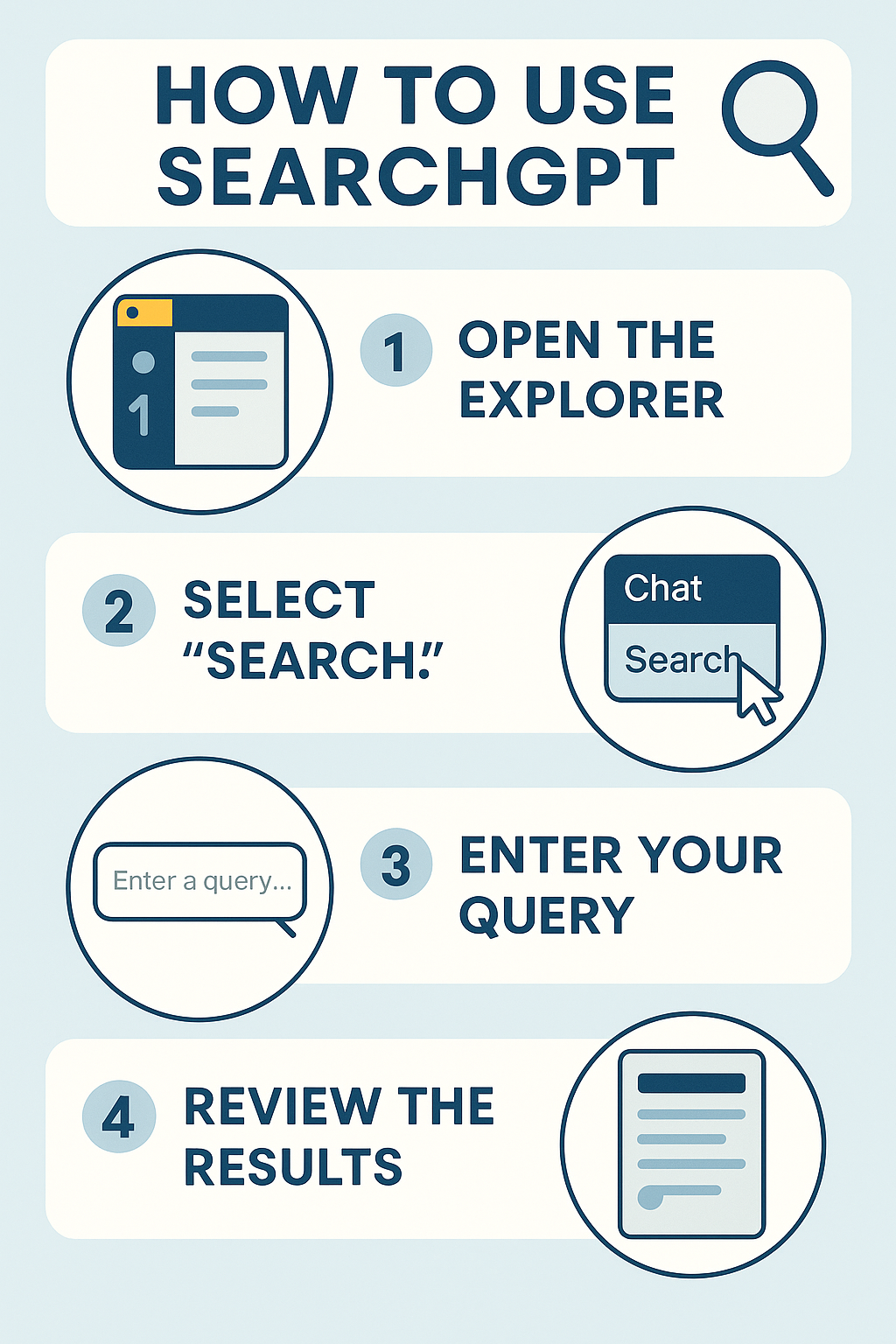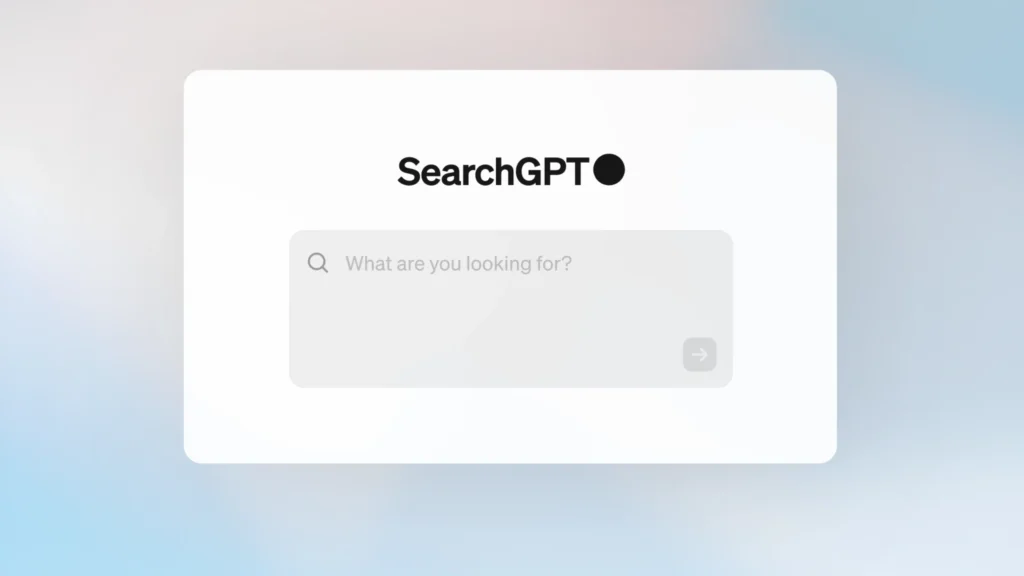What Is SearchGPT?
SearchGPT is OpenAI’s groundbreaking AI-powered search engine that combines the conversational capabilities of ChatGPT with real-time web information. Unlike traditional search engines that return lists of links, SearchGPT provides direct, conversational answers with clear source attribution.
Launched initially as a prototype in July 2024, SearchGPT has evolved into an integrated feature within ChatGPT, offering users a more intuitive and interactive search experience. The search engine uses advanced natural language processing to understand user intent rather than simply matching keywords.

How Does SearchGPT Work?
SearchGPT operates using a sophisticated combination of AI technologies and real-time data access. The system uses a fine-tuned version of GPT-4o that has been enhanced with synthetic data generation techniques and integrated with OpenAI’s o1-preview system.
Key Technical Components
Natural Language Processing: SearchGPT interprets user queries by understanding context and intent, not just keywords. This allows for more conversational and nuanced searches compared to traditional engines.
Real-Time Web Integration: The platform leverages third-party search providers, including Microsoft’s Bing index, to access current information across the web. This ensures users receive up-to-date results rather than outdated training data.
Source Attribution System: Every response includes clear citations and a sources sidebar, allowing users to verify information and explore topics further.
What Are SearchGPT’s Key Features?
SearchGPT offers several revolutionary features that distinguish it from conventional search engines:
Conversational Interface
Users can engage in natural dialogue with the search engine, asking follow-up questions that maintain context throughout the conversation. This creates a more dynamic and personalized search experience.
Direct Answer Generation
Instead of presenting lists of links, SearchGPT synthesizes information from multiple sources to provide concise, direct answers to user queries.
Real-Time Information Access
The platform delivers current data including news, sports scores, stock prices, and weather updates through its integration with live web sources.
Visual and Interactive Elements
SearchGPT can include images, graphs, charts, and interactive elements like stock graphs and maps to enhance understanding of complex topics.
Contextual Memory
The system remembers previous interactions within a session, allowing for more coherent follow-up questions and refined searches.

How To Use SearchGPT: Step-by-Step Guide
Getting started with SearchGPT is straightforward for both free and paid ChatGPT users:
Step 1: Access SearchGPT
Navigate to chatgpt.com and log in to your account. SearchGPT is available to all ChatGPT users, with enhanced features for paid subscribers.
Step 2: Identify Search Queries
SearchGPT automatically determines when to search the web based on your query, or you can manually trigger searches using the dedicated search icon.
Step 3: Ask Clear, Specific Questions
For optimal results, formulate clear and specific questions. For example, instead of asking “tell me about exercise,” ask “What are the health benefits of regular cardio exercise?”
Step 4: Utilize Follow-Up Questions
Take advantage of SearchGPT’s conversational nature by asking follow-up questions to dive deeper into topics without losing context.
Step 5: Verify Sources
Use the sources sidebar to verify information and explore original content for additional research.
SearchGPT vs Google: What’s the Difference?
The comparison between SearchGPT and Google reveals fundamental differences in search philosophy and user experience:

Search Approach
SearchGPT uses a conversational interface enabling natural language queries and follow-up interactions. Google relies on traditional keyword-based search where users enter terms and receive ranked results.
Result Presentation
SearchGPT provides direct, synthesized answers with clear source attribution. Google typically presents lists of website links, requiring users to click through multiple results.
Information Currency
SearchGPT aims to provide real-time information through live web data integration. Google maintains a vast indexed database that may include outdated information despite regular updates.
User Experience
SearchGPT maintains context across searches, creating a conversation-like experience. Google treats each search as an isolated query with no memory of previous interactions.
What Are SearchGPT’s Advantages and Disadvantages?
Advantages
Natural Interaction: Users can interact conversationally, making searches more intuitive and user-friendly.
Direct Answers: Eliminates the need to sift through multiple links to find information.
Source Transparency: Clear attribution allows users to verify information easily.
Context Retention: Maintains conversation history for more coherent follow-up queries.
Real-Time Data: Access to current information through live web integration.
Disadvantages
Limited Web Coverage: Currently relies on select partnerships rather than comprehensive web crawling like Google.
Potential Inaccuracies: AI responses may sometimes provide incorrect or incomplete information.
Dependency on Bing: Limited by the scope and quality of Bing’s search index.
Subscription Requirements: Full features require paid ChatGPT subscriptions.
What Does SearchGPT Cost?
SearchGPT pricing varies based on the ChatGPT plan you choose:
Free Plan
Cost: $0/month
Features: Limited access to SearchGPT with basic search capabilities
Limitations: Restricted usage and basic functionality
ChatGPT Plus
Cost: $20/month
Features: Extended SearchGPT access with advanced features
Benefits: Higher usage limits and priority access
ChatGPT Pro
Cost: $200/month
Features: Unlimited SearchGPT access with premium capabilities
Benefits: Access to latest features and models
Business Plans
ChatGPT Team: $25-30/month per user with collaborative features
ChatGPT Enterprise: Custom pricing starting around $60/user/month
How Will SearchGPT Impact SEO?
SearchGPT represents a significant shift in search technology that will affect SEO strategies:
Content Optimization Changes
Focus on Conversational Queries: Content should be optimized for natural language questions rather than just keywords.
Direct Answer Formatting: Structure content to provide clear, concise answers that AI can easily extract and cite.
Source Authority: Building credibility becomes crucial as SearchGPT emphasizes transparent source attribution.
Technical SEO Considerations
Bing Optimization: Since SearchGPT uses Bing’s index, optimizing for Bing becomes more important.
Structured Data: Implementing proper schema markup helps AI understand and extract relevant information.
What Are SearchGPT’s Limitations?
Despite its innovations, SearchGPT faces several challenges:
Information Accuracy: AI models can sometimes generate incorrect or misleading responses, requiring user verification.
Limited Database: Relies on partnerships and Bing’s index rather than comprehensive web crawling.
Context Dependency: Performance may vary based on query complexity and available source material.
Hallucination Risk: Like all AI systems, SearchGPT may occasionally generate plausible-sounding but incorrect information.
What Does the Future Hold for SearchGPT?
OpenAI has outlined several development priorities for SearchGPT’s evolution:
Planned Enhancements
Shopping and Travel Integration: Expanded capabilities for e-commerce and travel-related searches.
Advanced Voice Integration: Better integration with Advanced Voice and Canvas products.
Enhanced Reasoning: Leveraging o1-series models for deeper research capabilities.
Market Positioning
SearchGPT positions itself as a complementary tool rather than a complete Google replacement, focusing on conversational search experiences while Google maintains advantages in comprehensive web indexing.
Frequently Asked Questions About SearchGPT
Is SearchGPT Free?
SearchGPT is available in ChatGPT’s free tier with limited functionality, while paid plans offer enhanced features and usage limits.
How Accurate Is SearchGPT?
SearchGPT aims for high accuracy through source attribution, but users should verify important information independently.
Can SearchGPT Replace Google?
While innovative, SearchGPT complements rather than replaces Google, serving different search needs and use cases.
What Makes SearchGPT Different from ChatGPT?
SearchGPT integrates real-time web data and source attribution, while standard ChatGPT relies on training data with knowledge cutoffs.
How Do I Access SearchGPT?
Access SearchGPT through chatgpt.com by logging into your account and using the search functionality integrated into the platform.
SearchGPT represents a fundamental shift toward more conversational, AI-powered search experiences. While it may not immediately replace traditional search engines, it offers a compelling alternative for users seeking direct answers and interactive search experiences. As the technology continues evolving, SearchGPT will likely play an increasingly important role in how we discover and interact with information online.




Pingback: DeepSeek AI: A Rising Star in the Open-Source AI Landscape - TechOreo Blog
Pingback: GEO Guide: Generative Engine Optimization for 2025 | TechOreo Blog
Pingback: Master Image Optimization for SEO - TechOreo Blog
Pingback: SEO Guide 2025: Complete Beginner's Manual for Rankings | TechOreo Blog